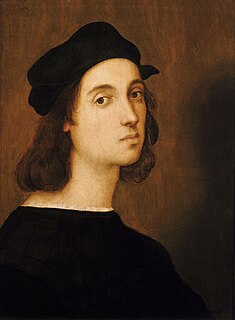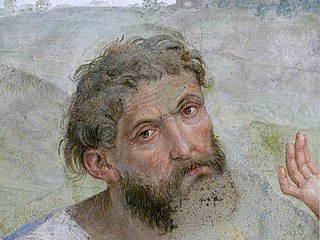
Raffaello Sanzio da Urbino, known as Raphael, was an Italian painter and architect of the High Renaissance. His work is admired for its clarity of form, ease of composition, and visual achievement of the Neoplatonic ideal of human grandeur. Together with Michelangelo and Leonardo da Vinci, he forms the traditional trinity of great masters of that period.

Pintoricchio or Pinturicchio whose birth name was Bernardino di Betto, also known as Benetto di Biagio or Sordicchio, was an Italian painter during the Renaissance. Born in Perugia in 1454 and dying in Siena in 1513, Pintoricchio acquired his nickname, meaning, because of his small stature. He also used it to sign some of his 15th and 16th century artworks.

Pietro Perugino, born Pietro Vannucci, was an Italian Renaissance painter of the Umbrian school, who developed some of the qualities that found classic expression in the High Renaissance. Raphael was his most famous pupil.

Lo Spagna, "the Spaniard" in Italian, was a painter of the High Renaissance, active in central Italy. His name was Giovanni di Pietro, but he was known as Lo Spagna because he was born in Spain. After Raphael, he was a main pupil and follower of the Umbrian painter Perugino, whose style his paintings develop. He should not be confused with Pietro di Giovanni D'Ambrogio of Siena.

The Marriage of the Virgin is a painting by the Italian Renaissance master Perugino, although it is now sometimes attributed to his pupil Lo Spagna. It depicts the marriage between Joseph and Mary, and is now in the Musée des Beaux-Arts of Caen, France. Initially commissioned to Pinturicchio for the recently completed cathedral of Perugia, Perugino took over the commission and finished the work around 1500–1504, probably after several periods of stasis.

La Belle Jardinière, also known as Madonna and Child with Saint John the Baptist, is a painting started by the Italian High Renaissance artist Raphael, and finished by Ridolfo del Ghirlandaio, that depicts the Madonna, a young Christ, and a young John the Baptist. It is believed to have been commissioned by the Sienese patrician Fabrizio Sergardi in approximately 1507-1508. It is currently displayed in the Louvre Museum in Paris, France.

Florentine painting or the Florentine School refers to artists in, from, or influenced by the naturalistic style developed in Florence in the 14th century, largely through the efforts of Giotto di Bondone, and in the 15th century the leading school of Western painting. Some of the best known painters of the earlier Florentine School are Fra Angelico, Botticelli, Filippo Lippi, the Ghirlandaio family, Masolino, and Masaccio.

Italian Renaissance painting is the painting of the period beginning in the late 13th century and flourishing from the early 15th to late 16th centuries, occurring in the Italian peninsula, which was at that time divided into many political states, some independent but others controlled by external powers. The painters of Renaissance Italy, although often attached to particular courts and with loyalties to particular towns, nonetheless wandered the length and breadth of Italy, often occupying a diplomatic status and disseminating artistic and philosophical ideas.

Giampietrino, probably Giovanni Pietro Rizzoli, was a north Italian painter of the Lombard school and Leonardo's circle, succinctly characterized by Sidney J. Freedberg as an "exploiter of Leonardo's repertory."

The Fano Altarpiece is a painting by the Italian Renaissance artist Pietro Perugino, executed in 1497, and housed in the church of Santa Maria Nuova, Fano, central Italy. It also includes a lunette with a Pietà and several predella panels.

Pietà is a painting by the Italian Renaissance artist Pietro Perugino, executed around 1483-1493, and housed in the Uffizi Gallery, Florence.

The Sant'Agostino Altarpiece is a painting by Perugino, produced in two stages between around 1502 and 1512 and then around 1513 to 1523. The altarpiece's 28, 29 or 30 panels were split up during the Napoleonic suppression of religious houses - most of its panels are now in the Galleria Nazionale dell'Umbria in Perugia. It is notable as the painter's last masterwork before he moved into his late phase producing more provincial commissions.

Madonna della Consolazione is a c.1496-1498 oil on panel painting by Perugino, now in the Galleria Nazionale dell'Umbria in Perugia. Produced at the same time as the artist's work on the Sala delle Udienze del Collegio del Cambio, it was completed in April 1498.

Crucifixion is a painting of the Crucifixion of Christ, usually attributed to Perugino, with or without assistance from Luca Signorelli. The work's dating and attribution are both uncertain - Venturi and Schmarsow attribute it to a pupil of Perugino, whilst other art historians attribute it to Perugino alone or with assistance from Signorelli. The deep chiaroscuro is comparable to Signorelli's style elsewhere or to the early style of Perugino whilst he was still heavily influenced by Verrochio. The landscape background is typical of Perugino, with mountains and hills in deep perspective.

Nativity of the Virgin is a small tempera on panel painting by Perugino, dating to around 1472 and now in the Walker Art Gallery in Liverpool. It shows the nativity of Mary. The style of the house is heavily influenced by Andrea del Verrocchio

Miracle of the Snow is a tempera on panel painting by Perugino, dating to around 1472 and now in the collection of Polesden Lacey. It shows the miraculous fall of snow which marked the spot for the foundation of Santa Maria Maggiore in Rome in 352.

Madonna and Child with St John the Baptist and St Catherine of Alexandria is a c.1495 oil on panel painting by Perugino of the Madonna and Child with John the Baptist and Catherine of Alexandria. It is now in the Louvre in Paris.

Madonna and Child with Two Saints is a tempera on panel painting by Perugino, dating to around 1495. It is now in the Kunsthistorisches Museum in Vienna. The saint to the right is Catherine of Alexandria, whilst the saint to the left is unidentified but may be Rose of Viterbo or Mary Magdalene.

The Madonna of Loreto is a c.1507 oil on panel painting by Perugino, now in the National Gallery, London, which bought it in 1879. It shows the Madonna and Child flanked by Jerome (left) and Francis of Assisi (right). Two angels hover over Mary's head holding a crown. It reuses the low parapet from Madonna and Child with St Rose and St Catherine (1492) and probably also involved the master's studio assistants.

The Diotallevi Madonna is a c.1504 oil on panel painting by Raphael, now in the Bode Museum in Berlin, which it entered in 1841-1842 from marquess Diotallevi's collection in Rimini. Previously attributed to Raphael's teacher Perugino, almost all art historians now attribute it to Raphael, with the exception of Adolfo Venturi who attributed it and parts of Perugino's Madonna della Consolazione to an anonymous "Master of the Diotallevi Madonna".




















